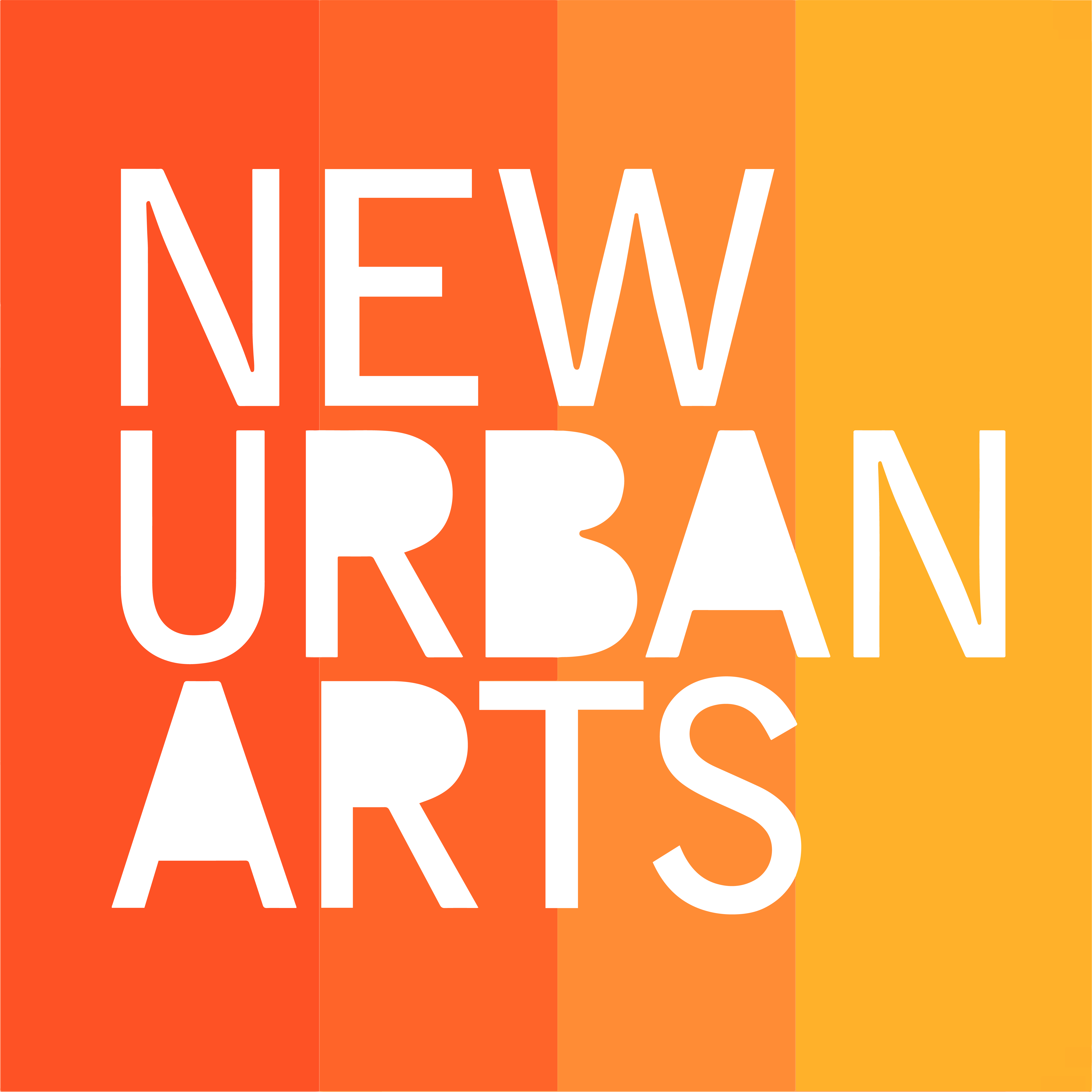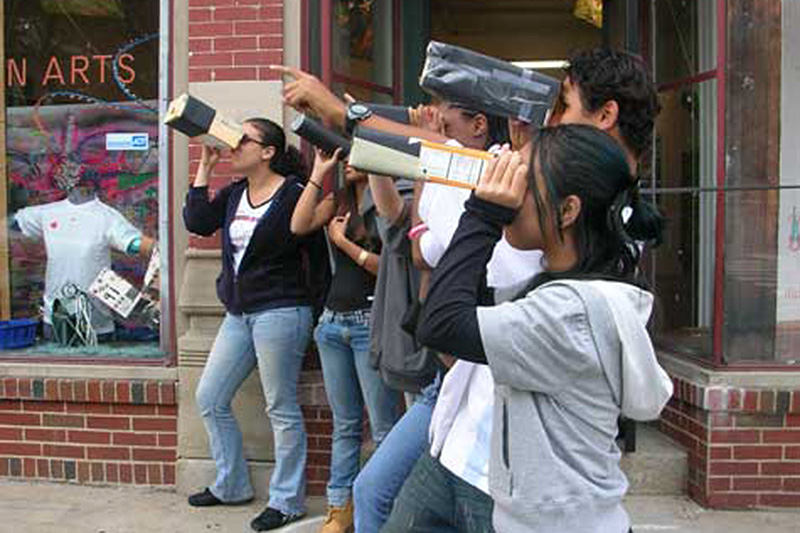Founding Board Chair and Artist Mentor Fellow, Peter Hocking, talks with Felice Cleveland about New Urban Arts.
DESIGN SPONGE | MAY 2009 | FELICE CLEVELAND
During my first semester of grad school at RISD in the Art + Design Education Department (with a focus on Community Arts) I was enrolled in a class called Digital Diary. Each week we met at New Urban Arts and taught/mentored/played with a group of high school students on the subject of Digital Photography. We loaned them a digital camera for the semester and we taught them various tricks and held informal critiques and slowly learned about the students through the photographs they took each week. The students who barely answered the question about which grade they were in the first week, a few weeks in were describing in detail their friends from school, their homes, their siblings and the streets of Providence—all illustrated through their photographs.
I was sold on Community Arts before encountering New Urban Arts, but all the time I spent there just continued to cement for me how important the out-of-school/community element is education and also to personal and social well-being. Peter Hocking generously answered some of my questions about New Urban Arts and their innovative programming. Basically it all boils down to the fact that students can be artists and leaders and the studio is really their space. (Thank you Peter and Sarah!)
When I tell people I studied “Community Arts,” I am often faced with a questioning look or a blank stare. How would you define that term?
PH: I think the blank stare is related to the ambiguity of the term – and a general problem with defining how “community arts practices” differ from traditional art practices and art education. Those who become involved with community-based arts program intuitively understand that the goals and aspirations of such program dramatically differ from established and mainstream arts efforts. Because of funding mechanisms and politics, the implied critique of such programs – such as the exclusion of broad members of communities and the elitism of the arts and art education – are minimized in order to secure the funding necessary to proceed with important community-based programs.
In my experience, Community Arts programs tend to be concerned with the inclusion (in the arts) of all people – regardless of traditional inclusion, myths about “talent,” or the hierarchy of styles and tastes that define the elite art markets, museums, and art education programs. Community Arts programs often seek to cultivate creative practice in participants – rather than being solely focused on notions of aesthetic excellence or training.
What is your involvement with New Urban Arts?
PH: I was the founding board chair from 1997-2001. For the past two years, I have been one of two Artist Mentor Fellows – which means that I have been working with staff and Artist Mentors to support the practice, professional development and learning of Art Mentors (teachers) in the program.
What are some of the projects that are happening right now at New Urban Arts?
PH: The center of New Urban Arts’ program is the Studio Program – which runs afterschool from 3 PM to 7 PM between October and May. This program provides 4-8 workshops each day for high school students and provides a context for Art Mentors and students to build rich learning relationships. Many other on-going projects grow from this effort – such as the annual ‘zine, Flip; the all-night Art Lock-In, which happens during April school vacation; Open Mic programs for local youth to read and perform; and quarterly gallery shows for youth and Art Mentors.
In addition to this activity, New Urban Arts also runs a Summer Inquiry Project, which allows a dozen high school students to work intensely with Art Mentors and visiting artists for six weeks each summer. The Creative Conversation Series provides a venue for local creative practitioners to discuss their practice and process in an open and educational way.
One of the exciting dimensions of New Urban Arts is that new projects grow organically each year from the specific interests and vibrancy of the community.
What is the role of Community Arts (and specifically NUA) in Providence?
PH: I think Community Arts programs are growing in Providence and are beginning to be understood as an important part of the artistic diversity of the city. While traditional venues for the arts remain a vital part of Providence, I believe that Community Arts programs are beginning to increase participation in all arts programs because they are welcoming to people with a broad range of experiences in the arts. They also cultivate relationships across difference and experience – enabling unusual conversations to emerge.
How is art at NUA different from art that these students receive in school?
PH: New Urban Arts operates more like a professional studio – enabling learners and practitioners to follow an idea, impulse or line of inquiry in a way that enables discovery and unanticipated learning. Most art curriculums are focused on teaching a curriculum of skills – regardless of context or the particular needs and interests of learners. While school-based arts education programs have tremendous value for students wishing to pursue post-secondary education in the arts, they can emphasize technique over creative process. Community Arts programs, especially for students who are also receiving school-based arts education, allow learners to elaborate on the content that matters to them and to begin the process of connecting their creative skills with other areas in their life – for example, applying creative problem solving to questions that may not immediately call for creativity.
How has NUA grown and changed throughout the years?
PH: An amazing thing about New Urban Arts is that it’s deepened its practice without fundamentally changing its intentions. The aspects of the program that I’ve described above have become more effective through a strong oral history and a broadly agreed upon culture of sharing learning and practice. New Urban Arts reflects a culture in which people are supported to succeed, but also enabled to take risks and to fail. This open spirit allows for the program to grow and evolve without having to make radical or dramatic turns and shifts. Consequently, the space remains inviting and safe for a variety of participants – both learners and teachers.
Where is NUA headed?
PH: The organization has been in the process of strategic planning for the past year and will be publishing the plan in the next few months. It doesn’t point the organization in dramatically new directions, but helps to grow and build upon the assets ad strengths of our model. In addition, we continue to think about and develop strategies for sharing our approach and what we know about community arts with people outside the organization.
Original Article
PDF

